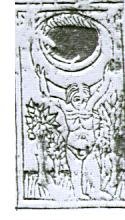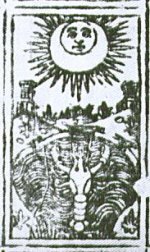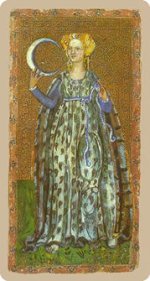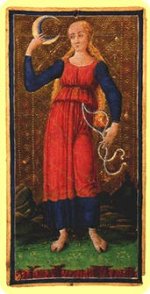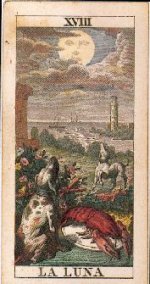catboxer
...is one of the most mysterious cards, and alongside XII Le Pendu one of the most perplexing. A one-word, very general interpretation might be "reflection," as the moon is, astronomically speaking a gigantic reflector of the sun's light. It's the cosmic eye of the soul reflecting upon itself.
The moon was also the most important deity of the matriarchal neolithic societies. In her, our prehistoric ancestors saw their triple goddess: as maiden when new, as nyph when full, and as crone when waning. Her 28-day cycle also connected her with the universal female in the most concrete way.
The earliest moon cards we have are the uninspired Visconti products -- full-length portraits of a woman holding a crescent -- as discussed in the Star thread. But woodcut artists producing crude editions of tarocchi for mass consumption came up with a more appropriate pictorial treatment perhaps as early as the latter decades of the 15th century. Moon cards from a single set of blocks, housed today in New York's Metropolitan Museum and also in the Budapest Museum of Fine Arts show a putto holding up a full moon which contains a single gigantic eyeball. (See attached.) This shows a wonderful, instinctive grasp of the celestial object's symbolic meaning, one with roots older than time and sunk deep in the collective unconscious of the race. We look at our whole, entire beings in the full faces of our own internal moons, living out the words of the old nursery rhyme: "I see the moon and the moon sees me."
(to be continued)
The moon was also the most important deity of the matriarchal neolithic societies. In her, our prehistoric ancestors saw their triple goddess: as maiden when new, as nyph when full, and as crone when waning. Her 28-day cycle also connected her with the universal female in the most concrete way.
The earliest moon cards we have are the uninspired Visconti products -- full-length portraits of a woman holding a crescent -- as discussed in the Star thread. But woodcut artists producing crude editions of tarocchi for mass consumption came up with a more appropriate pictorial treatment perhaps as early as the latter decades of the 15th century. Moon cards from a single set of blocks, housed today in New York's Metropolitan Museum and also in the Budapest Museum of Fine Arts show a putto holding up a full moon which contains a single gigantic eyeball. (See attached.) This shows a wonderful, instinctive grasp of the celestial object's symbolic meaning, one with roots older than time and sunk deep in the collective unconscious of the race. We look at our whole, entire beings in the full faces of our own internal moons, living out the words of the old nursery rhyme: "I see the moon and the moon sees me."
(to be continued)

